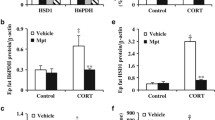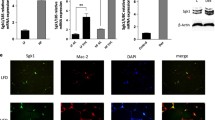Abstract
Background
Hepatic 11β-hydroxysteroid dehydrogenase type 1 (11β-HSD1) activity, which converts cortisone (inactive) to cortisol, is downregulated in obesity. However, this compensation fails in obese with metabolic abnormalities, such as diabetes. To further characterize the tissue-specific cortisol regeneration in obesity, we have investigated the mRNA expression of genes related to local cortisol production, i.e., 11β-HSD1, hexose-6-phosphate dehydrogenase (H6PDH) and cortisol action, glucocorticoid receptor (GR) and a cortisol target gene, phosphoenolpyruvate carboxykinase (PEPCK) in the liver, and visceral (VAT) and subcutaneous (SAT) adipose tissues from morbidly obese patients with and without metabolic syndrome (MS).
Methods
Fifty morbidly obese patients undergoing bariatric surgery, 14 men (mean age, 41.3 ± 3.5 years; BMI, 48.0 ± 3.6 kg/m2) and 36 women (mean age, 44.6 ± 1.9 years; BMI, 44.9 ± 1.2 kg/m2), were classified as having MS (MS+, n = 20) or not (MS−, n = 30). Tissue mRNA levels were measured by real-time polymerase chain reaction.
Results
Hepatic mRNA levels of these genes were higher in obese patients with MS (11β-HSD1, P = 0.002; H6PDH, P = 0.043; GR, P = 0.033; PEPCK, P = 0.032) and positively correlated with the number of clinical characteristics that define the MS. The expression of the four genes positively correlated among them. In contrast to the liver, these genes were not differently expressed in VAT or SAT, when MS+ and MS− obese patients were compared.
Conclusions
Coordinated liver-specific upregulation of genes involved in local cortisol regeneration and action support the concept that local hepatic hypercortisolism contributes to development of MS in morbidly obese patients.



Similar content being viewed by others
References
Anagnostis P, Athyros VG, Tziomalos K, et al. Clinical review: the pathogenetic role of cortisol in the metabolic syndrome: a hypothesis. J Clin Endocrinol Metab. 2009;94:2692–701.
Cooper MS, Stewart PM. 11Beta-hydroxysteroid dehydrogenase type 1 and its role in the hypothalamus-pituitary-adrenal axis, metabolic syndrome, and inflammation. J Clin Endocrinol Metab. 2009;94:4645–54.
Tomlinson JW, Walker EA, Bujalska IJ, et al. 11β-hydroxysteroid dehydrogenase type 1: a tissue-specific regulator of glucocorticoid response. Endocr Rev. 2004;25:831–66.
Atanasov AG, Nashev LG, Schweizer RA, et al. Hexose-6-phosphate dehydrogenase determines the reaction direction of 11beta-hydroxysteroid dehydrogenase type 1 as an oxoreductase. FEBS Lett. 2004;571:129–33.
Lavery GG, Walker EA, Draper N, et al. Hexose-6-phosphate dehydrogenase knock-out mice lack 11 beta-hydroxysteroid dehydrogenase type 1-mediated glucocorticoid generation. J Biol Chem. 2006;281:6546–51.
Kotelevtsev Y, Holmes MC, Burchell A, et al. 11Beta-hydroxysteroid dehydrogenase type 1 knockout mice show attenuated glucocorticoid-inducible responses and resist hyperglycemia on obesity or stress. Proc Natl Acad Sci U S A. 1997;94:14924–29.
Masuzaki H, Paterson J, Shinyama H, et al. A transgenic model of visceral obesity and the metabolic syndrome. Science. 2001;294:2166–70.
Paterson JM, Morton NM, Fievet C, et al. Metabolic syndrome without obesity: hepatic overexpression of 11beta-hydroxysteroid dehydrogenase type 1 in transgenic mice. Proc Natl Acad Sci U S A. 2004;101:7088–93.
Palermo M, Shackleton CH, Mantero F, et al. Urinary free cortisone and the assessment of 11 beta-hydroxysteroid dehydrogenase activity in man. Clin Endocrinol (Oxf). 1996;45:605–11.
Stewart PM, Wallace AM, Atherden SM, et al. Mineralocorticoid activity of carbenoxolone: contrasting effects of carbenoxolone and liquorice on 11 beta-hydroxysteroid dehydrogenase activity in man. Clin Sci (Lond). 1990;78:49–54.
Stewart PM, Boulton A, Kumar S, et al. Cortisol metabolism in human obesity: impaired cortisone → cortisol conversion in subjects with central adiposity. J Clin Endocrinol Metab. 1999;84:1022–7.
Rask E, Olsson T, Soderberg S, et al. Tissue-specific dysregulation of cortisol metabolism in human obesity. J Clin Endocrinol Metab. 2001;86:1418–21.
Rask E, Walker BR, Soderberg S, et al. Tissue-specific changes in peripheral cortisol metabolism in obese women: increased adipose 11beta-hydroxysteroid dehydrogenase type 1 activity. J Clin Endocrinol Metab. 2002;87:3330–6.
Valsamakis G, Anwar A, Tomlinson JW, et al. 11Beta-hydroxysteroid dehydrogenase type 1 activity in lean and obese males with type 2 diabetes mellitus. J Clin Endocrinol Metab. 2004;89:4755–61.
Tomlinson JW, Moore JS, Clark PM, et al. Weight loss increases 11beta-hydroxysteroid dehydrogenase type 1 expression in human adipose tissue. J Clin Endocrinol Metab. 2004;89:2711–6.
Westerbacka J, Yki-Jarvinen H, Vehkavaara S, et al. Body fat distribution and cortisol metabolism in healthy men: enhanced 5beta-reductase and lower cortisol/cortisone metabolite ratios in men with fatty liver. J Clin Endocrinol Metab. 2003;88:4924–31.
Sandeep TC, Andrew R, Homer NZ, et al. Increased in vivo regeneration of cortisol in adipose tissue in human obesity and effects of the 11beta-hydroxysteroid dehydrogenase type 1 inhibitor carbenoxolone. Diabetes. 2005;54:872–9.
Desbriere R, Vuaroqueaux V, Achard V, et al. 11Beta-hydroxysteroid dehydrogenase type 1 mRNA is increased in both visceral and subcutaneous adipose tissue of obese patients. Obesity (Silver Spring). 2006;14:794–8.
Mariniello B, Ronconi V, Rilli S, et al. Adipose tissue 11beta-hydroxysteroid dehydrogenase type 1 expression in obesity and Cushing’s syndrome. Eur J Endocrinol. 2006;155:435–41.
Veilleux A, Rheaume C, Daris M, et al. Omental adipose tissue type 1 11 beta-hydroxysteroid dehydrogenase oxoreductase activity, body fat distribution, and metabolic alterations in women. J Clin Endocrinol Metab. 2009;94:3550–7.
Tomlinson JW, Sinha B, Bujalska I, et al. Expression of 11beta-hydroxysteroid dehydrogenase type 1 in adipose tissue is not increased in human obesity. J Clin Endocrinol Metab. 2002;87:5630–5.
Paulmyer-Lacroix O, Boullu S, Oliver C, et al. Expression of the mRNA coding for 11beta-hydroxysteroid dehydrogenase type 1 in adipose tissue from obese patients: an in situ hybridization study. J Clin Endocrinol Metab. 2002;87:2701–5.
Kannisto K, Pietilainen KH, Ehrenborg E, et al. Overexpression of 11beta-hydroxysteroid dehydrogenase-1 in adipose tissue is associated with acquired obesity and features of insulin resistance: studies in young adult monozygotic twins. J Clin Endocrinol Metab. 2004;89:4414–21.
Engeli S, Bohnke J, Feldpausch M, et al. Regulation of 11beta-HSD genes in human adipose tissue: influence of central obesity and weight loss. Obes Res. 2004;12:9–17.
Lindsay RS, Wake DJ, Nair S, et al. Subcutaneous adipose 11 beta-hydroxysteroid dehydrogenase type 1 activity and messenger ribonucleic acid levels are associated with adiposity and insulinemia in Pima Indians and Caucasians. J Clin Endocrinol Metab. 2003;88:2738–44.
Uckaya G, Karadurmus N, Kutlu O, et al. Adipose tissue 11-beta-hydroxysteroid dehydrogenase type 1 and hexose-6-phosphate dehydrogenase gene expressions are increased in patients with type 2 diabetes mellitus. Diabetes Res Clin Pract. 2008;82 Suppl 2:S135–40.
Koska J, de Courten B, Wake DJ, et al. 11Beta-hydroxysteroid dehydrogenase type 1 in adipose tissue and prospective changes in body weight and insulin resistance. Obesity (Silver Spring). 2006;14:1515–22.
Tomlinson JW, Finney J, Gay C, et al. Impaired glucose tolerance and insulin resistance are associated with increased adipose 11beta-hydroxysteroid dehydrogenase type 1 expression and elevated hepatic 5alpha-reductase activity. Diabetes. 2008;57:2652–60.
Muñoz R, Carvajal C, Escalona A, et al. 11Beta-hydroxysteroid dehydrogenase type 1 is overexpressed in subcutaneous adipose tissue of morbidly obese patients. Obes Surg. 2009;19:764–70.
Grundy SM, Cleeman JI, Daniels SR, et al. Diagnosis and management of the metabolic syndrome: an American Heart Association/National Heart, Lung, and Blood Institute scientific statement. Circulation. 2005;112:2735–52.
Iwasaki Y, Takayasu S, Nishiyama M, et al. Is the metabolic syndrome an intracellular Cushing state? Effects of multiple humoral factors on the transcriptional activity of the hepatic glucocorticoid-activating enzyme (11beta-hydroxysteroid dehydrogenase type 1) gene. Mol Cell Endocrinol. 2008;285:10–8.
Liu Y, Nakagawa Y, Wang Y, et al. Increased glucocorticoid receptor and 11{beta}-hydroxysteroid dehydrogenase type 1 expression in hepatocytes may contribute to the phenotype of type 2 diabetes in db/db mice. Diabetes. 2005;54:32–40.
Morton NM, Densmore V, Wamil M, et al. A polygenic model of the metabolic syndrome with reduced circulating and intra-adipose glucocorticoid action. Diabetes. 2005;54:3371–8.
Livingstone DE, Jones GC, Smith K, et al. Understanding the role of glucocorticoids in obesity: tissue-specific alterations of corticosterone metabolism in obese zucker rats. Endocrinology. 2000;141:560–3.
Baudrand R, Carvajal CA, Riquelme A. Overexpression of 11beta-hydroxysteroid dehydrogenase type 1 in hepatic and visceral adipose tissue is associated with metabolic disorders in morbidly obese patients. Obes Surg. 2010;20:77–83.
Simonyte K, Rask E, Naslund I, et al. Obesity is accompanied by disturbances in peripheral glucocorticoid metabolism and changes in FA recycling. Obesity (Silver Spring). 2009;17:1982–7.
Wang Y, Nakagawa Y, Liu L, et al. Tissue-specific dysregulation of hexose-6-phosphate dehydrogenase and glucose-6-phosphate transporter production in db/db mice as a model of type 2 diabetes. Diabetologia. 2011;54:440–50.
Yabaluri N, Bashyam MD. Hormonal regulation of gluconeogenic gene transcription in the liver. J Biosci. 2010;35:473–84.
Alberts P, Engblom L, Edling N, et al. Selective inhibition of 11beta-hydroxysteroid dehydrogenase type 1 decreases blood glucose concentrations in hyperglycaemic mice. Diabetologia. 2002;45:1528–32.
Bhat BG, Younis H, Herrera J, et al. Antisense inhibition of 11bhydroxysteroid dehydrogenase type 1 improves diabetes in a novel cortisone-induced diabetic KK mouse model. Biochem Biophys Res Com. 2008;365:740–5.
Edgerton DS, Basu R, Ramnanan CJ, et al. Effect of 11b-hydroxysteroid dehydrogenase-1 inhibition on hepatic glucose metabolism in the conscious dog. Am J Physiol Endocrinol Metab. 2010;298:E1019–26.
Balkau B, Valensi P, Eschwege E, et al. A review of the metabolic syndrome. Diabetes Metab. 2007;3:405–13.
Rosenstock J, Banarer S, Fonseca VA, et al. The 11-beta-hydroxysteroid dehydrogenase type 1 inhibitor INCB13739 improves hyperglycemia in patients with type 2 diabetes inadequately controlled by metformin monotherapy. Diabetes Care. 2010;33:1516–22.
Morton NM. Obesity and corticosteroids: 11b-hydroxysteroid type 1 as a cause and therapeutic target in metabolic disease. Mol Cell Endocrinol. 2010;316:154–64.
Acknowledgments
The authors thank Rocío González González and Marina Pollán Santamaría for their excellent statistical assistance. This work was supported by Research Grants FMM 07 (to M.A.R.) and FMM 11 (to G.F.V.) from the Mutua Madrileña Foundation (Madrid, Spain) and by a 2009 award from Sendimad. E.T.G. is a Post-doctoral Fellow supported by the Mutua Madrileña Foundation.
Conflicts of interest
None.
Author information
Authors and Affiliations
Corresponding author
Rights and permissions
About this article
Cite this article
Torrecilla, E., Fernández-Vázquez, G., Vicent, D. et al. Liver Upregulation of Genes Involved in Cortisol Production and Action Is Associated with Metabolic Syndrome in Morbidly Obese Patients. OBES SURG 22, 478–486 (2012). https://doi.org/10.1007/s11695-011-0524-9
Published:
Issue Date:
DOI: https://doi.org/10.1007/s11695-011-0524-9




